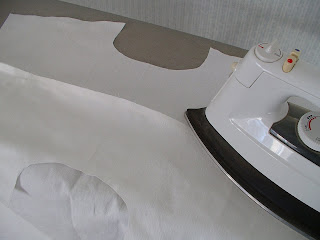
I finally gave up fiddling with the shirt pattern because other people in
MPB Men's Shirt Sew-Along over on
Peter's blog have already got their muslin finished. So I pinned some of the pattern pieces to an old sheet I bought from a charity store to use as a muslin. I've only cut out the two yoke pieces, the two front pieces and the back. I'll do the rest later. I might not even do the collar until my son has a chance to try the muslin on so I can see if the neck opening is the right size and at the correct height.

I started by pinning (the green pin) and then basting the pleats on the back piece. Then I put the back piece between the two (wrong sides out) yoke pieces and sewed through the three layers. I read somewhere that you should press all of your seams on both sides before moving on to the next step, so that is what I'm going to do.

Next was ironing to turn the seam allowance towards the yoke. I turned the whole thing over and ironed the other side the same way. After that I put both yoke pieces wrong sides together and ironed them from the outside. I decided to do the top-stitching on the yoke now because there wasn't as much material to move around. As this is the muslin I did the row of top-stitching and didn't bother to look where it should be. I just went and checked four of my son's store-bought shirts and the top-stitching on them is right at the edge and I did it 7 mm away! Oh well.

There is a way of finishing the shirt yoke called the burrito. I tried to look at it from people's blogs because I wasn't getting it. The pattern I'm using doesn't have a separate piece for the button 'placket' (is it then a placket?) so I didn't have to worry about that. The way I did it was to have the wrong sides of the front and back pieces facing and pin them together. Opening up the two yoke pieces I laid the wrong sides of the yokes down on the table.

Then I took the back piece and rolled it up and laid it on the yoke piece that was already pinned. I did the same to the front piece so that the pins were laying on the table.

I brought the unpinned yoke edge up and over the rolled pieces to meet with the pinned edges and pinned it to them. I sewed the seam, ironed it and repeated the steps with the other front piece.
Everything was turned right side out, ironed and I'll top-stitched close to the edge when there's daylight again!
Oops. I just read on Peter's blog that you should start by stay-stitching the neckline. I've done it now.
 My son was home for the weekend so he was able to try on the muslin. There's lots that needs to be changed. Mostly on the back though and I'll have to think about how to do it.
My son was home for the weekend so he was able to try on the muslin. There's lots that needs to be changed. Mostly on the back though and I'll have to think about how to do it. I should have finished my notes as I was doing the sections because I'm not sure if I remember everything now. Mike Maldonado has a video tutural for one way of doing flat-felled seams. Instead of putting the raw edges together, sewing the seam allowance, triming one side and then folding the wider edge over and under the trimmed one before edge stitching, he shows a quicker method. He starts by leaving a gap between the edges. Then sews the seam allowance and doesn't have to trim back one of the edges because it is already shorter than the other side. The back of my muslin is much wider than the front. As I wanted to try method I used the back for the wider side and with right sides together made the difference between them 6mm.
I should have finished my notes as I was doing the sections because I'm not sure if I remember everything now. Mike Maldonado has a video tutural for one way of doing flat-felled seams. Instead of putting the raw edges together, sewing the seam allowance, triming one side and then folding the wider edge over and under the trimmed one before edge stitching, he shows a quicker method. He starts by leaving a gap between the edges. Then sews the seam allowance and doesn't have to trim back one of the edges because it is already shorter than the other side. The back of my muslin is much wider than the front. As I wanted to try method I used the back for the wider side and with right sides together made the difference between them 6mm.
 I wanted the seam to be facing the same way on both sides. So for one sleeve I had to start from the hem and sew to the cuff.
I wanted the seam to be facing the same way on both sides. So for one sleeve I had to start from the hem and sew to the cuff. And for the other the cuff to the hem. I was sure that this seam was going to be difficult but once I had the shirt postioned correctly the sewing was no problem.
And for the other the cuff to the hem. I was sure that this seam was going to be difficult but once I had the shirt postioned correctly the sewing was no problem.


















